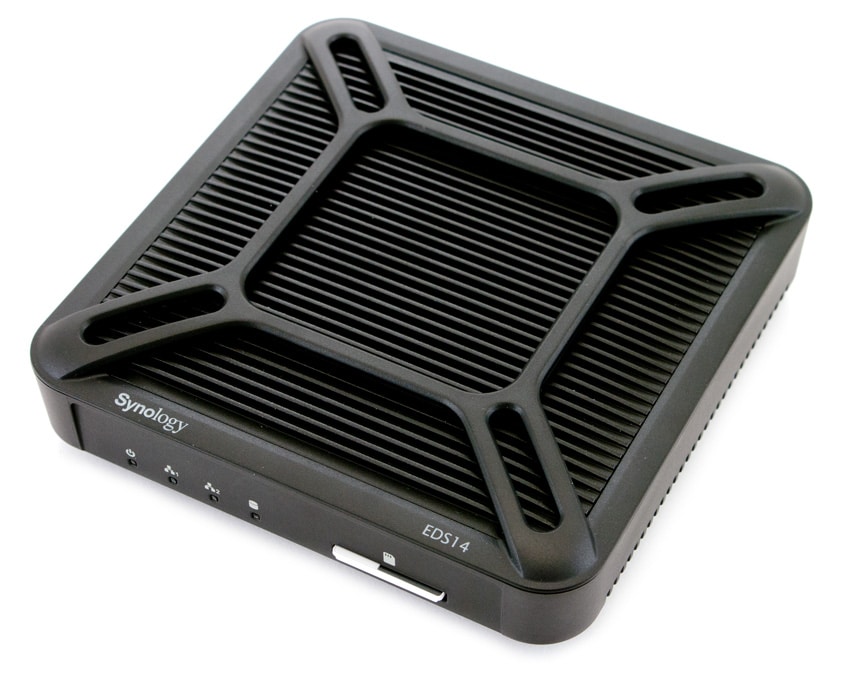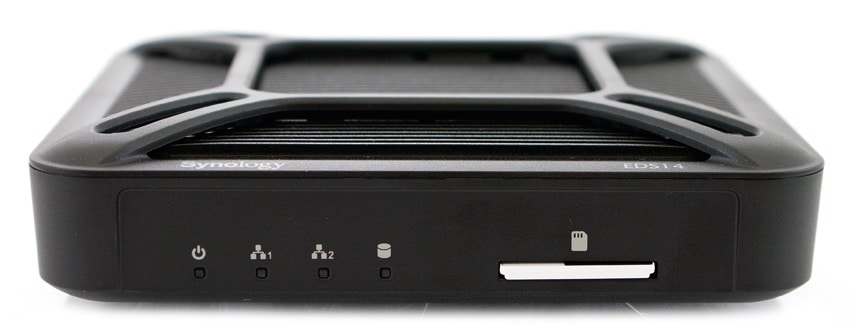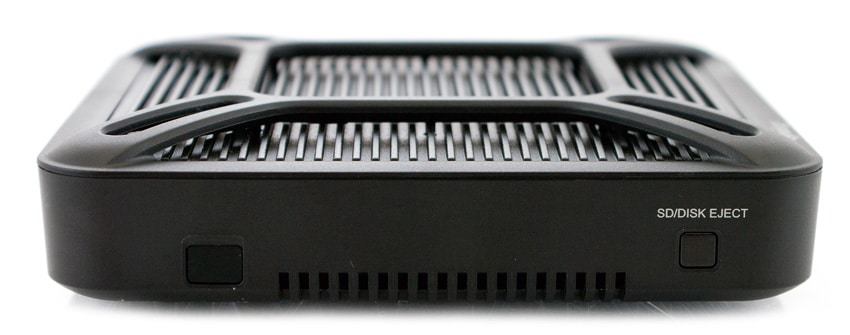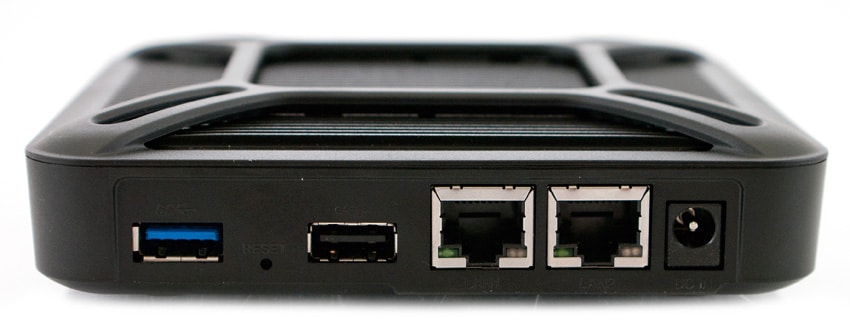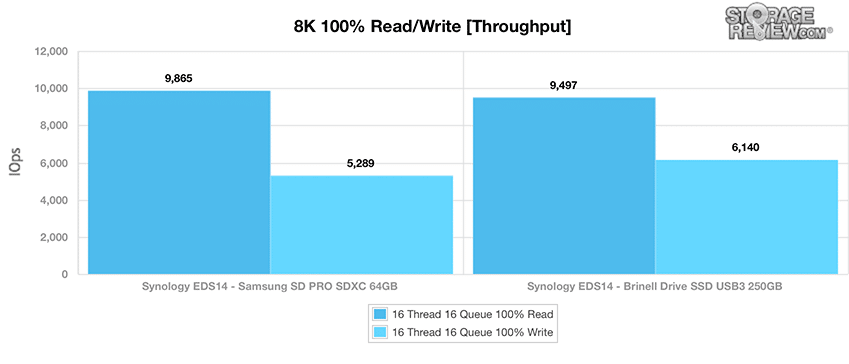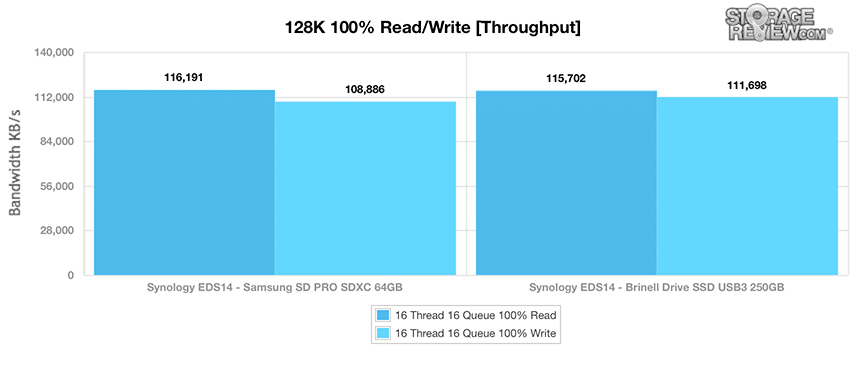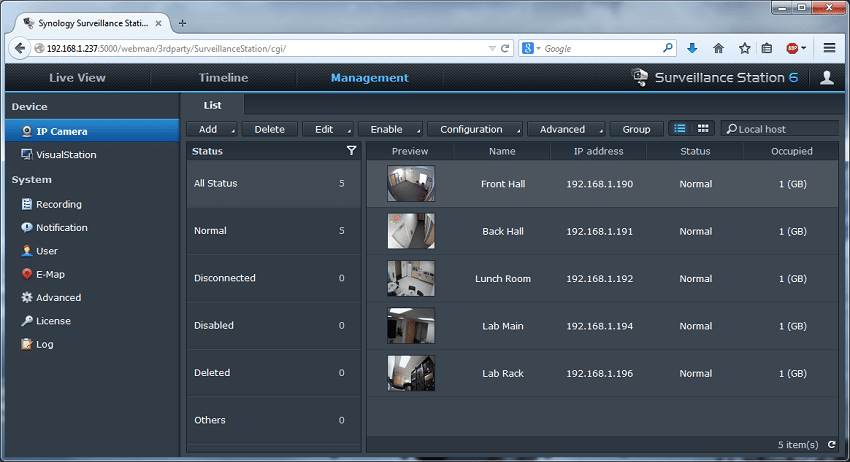
Synology has designed a new diskless and fan-less NAS specifically for law enforcement and military implementations. The EDS14 is an extremely durable and versatile (it is hailed as Synology's most versatile NAS yet) palm-sized NAS with a 1.2GHz CPU and 512MB of RAM. Additionally, it can be used with a wide range of DC input voltages (7 to 24V), which allows it to function in a variety of powering situations (including the cigarette lighter of a car), making this rugged NAS an ideal option for all kinds of automotive use cases, particularly with law enforcement and military vehicles. The EDS14 also can also be powered over PoE using splitters and its compact design of 125 x 125 x 31mm makes it roughly 70% smaller than a typical 2-bay NAS server and perfect for areas where space is an issue.
Synology reports read and write speeds of more than 111MB/s and 50MB/s, respectively, with USB 3.0-connected storage. Unique to the Synology NAS portfolio, the EDS14 ships with on-board NAND flash for the OS, rather that installing to the removable media. This makes it functional out of the box for quick deployment without having to rely on a USB drive or SD card to hold the OS. While the EDS14 can be used in many areas, Synology positions it as a rugged IP camera-recording platform. It was designed to make use of Synology's Surveillance Station, which was in turn designed to be used in very demanding enterprise surveillance situations. The Surveillance Station, a program that is compatible with 2,400 IP camera models, provides a live view of the cameras being used, features motion detection, and an alert system that notifies administrators via SMS, e-mail, Skype, and DS cam (an app made by Synology that was specifically made to provide camera and NAS access to iOS and Android phone platforms via QuickConnect).
Although the EDS14 wasn't optimized for media management, it can be used for that should the user wish; DS photo+, DS audio, and DS video apps (made by Synology) can be used to view and manage media stored on the device connected to the NAS. Users can schedule the powering on of peripheral devices remotely as well, which can be subsequently accessed and managed remotely over a 3G or 4G network, and the EDS14 is compatible across Windows, Mac, and Linux platforms.
The extreme durability of the EDS14 allows it to be used in many different places, including those exposed to extreme heat. It was constructed to be as energy efficient as possible, with smart cooling technology keeping the heat production in check without the use of an integrated fan. It carries a $499.99 price tag and 3-year warranty.
Specifications
- CPU Model: Marvell Armada 370
- CPU Frequency: 1.2GHz
- Memory: 512MB DDR3
- External Drives: EXT4, EXT3, FAT, NTFS, HFS+
- External ports: USB 2.0, USB 3.0, High Speed SDXC UHS-I SD
- Dimensions: 31mm x 125mm x 125mm
- Weight: 0.295kg
- LAN: Gigabit x2
- Wireless Support (Dongle)
- Power
- Power Supply: 24W
- AC Input Power Voltage: 100V to 240V AC
- Power Frequency: 50/60Hz, Single Phase
- Power Consumption:
- 8.66W (Access)
- 7.12W (Idle)
- Environmental
- Operating Temperature: -20ºC to 50ºC (-4ºF to 122ºF)
- Storage Temperature: -20ºC to 50ºC (-4ºF to 122ºF)
- Relative Humidity: 5% to 95%
- Certifications: FCC Class B, CE Class B, BSMI Class B
- Warranty: 3 years
Design and Build
The first impression from this device is that it is very small for a NAS; it is described by Synology as a "palm-sized NAS server." Unlike many of Synology's NAS servers, the EDS14 is much shorter than it is wide. The top of the device contains a large passive heatsink to shed heat. The face of the EDS14 has four LED lights corresponding to power, the two LAN inputs and storage access. To the right of the lights is the SDXC slot for on-board storage.
On the side of the EDS14 is an SD/disk eject button as well as the auxiliary DC output port with a cover. The bottom and sides have some venting as well. The schedulable DC output up to 1A allows users to power an external device when power outlets are unavailable.
Just by looking at this EDS14, you can tell that they designed this NAS with thermals in mind. Its smart cooling technology (i.e. passive cooling heatsink on top) helps to keep the system running cool at all times and is specifically programmed for uptime and good CPU health in surrounding temperatures as high as 50ºC. However, for high-heat environments above 38ºC, the Surveillance Station software drops down to 2 cameras versus the 5 that are normally supported.
The back of the EDS14 has a USB 3.0 port, a reset button, a USB 2.0 port, two LAN ports, and the AC adaptor (left to right).
Performance
To measure the performance of the Synology EDS14, we focused on sequential storage performance of a high-performance USB 3.0-connected external drive as well as a top-of-class SDXC card. Given the unique design of the EDS14 and its use case for IP camera recording, sequential storage access relates more to its intended I/O profile than mixed workloads. We measured performance of a 5GB section of each drive, mimicking a smaller file being written or read through the course of recording or playing back video.
Storage Devices Tested:
- Brinell Drive SSD 250GB (USB 3.0)
- Samsung SD Pro 64GB (SD card)
Our Enterprise Synthetic Workload Analysis includes two profiles based on real-world tasks. These profiles have been developed to make it easier to compare to our past benchmarks as well as widely published values.
- 8k (Sequential)
- 100% Read or 100% Write
- 100% 8k
- 128k (Sequential)
- 100% Read or 100% Write
- 100% 128k
In our first test measuring small-block sequential performance, we measured just under 10kIOPs for both the Samsung SDXC card as well as the Brinell USB 3.0 external SSD. Write speed from the Brinell USB 3.0 SSD topped 6100 IOPS and the Samsung SDXC card came in under 5300 IOPS. In both cases CPU performance was being pushed to its limits during these tests.
Our next test measuring large-block sequential performance saw speeds of 115.7MB/s read and 111.7MB/s write from the Brinell USB 3.0 SSD and 116.1MB/s read and 108.9MB/s write from the Samsung SDXC card. Since both of these tests were limited to using a single LAN interface, we measured performance with both devices being accessed at the same time. That test measured 188MB/s read and 83MB/s write. Write activity through both the SDXC and USB 3.0 interfaces pushed CPU utilization to 100%, lowering its overall performance.
With the main focus of this review being Surveillance Station use cases, we connected 5 AXIS IP Cameras to the Synology EDS14 and measured performance over a good chunk of a week, with motion tracking handled by the Synology. These cameras include two 720p P1354, two 720p M1144-L, and one 1080p M3025-VE set up in different areas of our office.
With each camera set to its highest resolution, 30FPS and high-quality variable bitrate, we recorded system vitals to see the impact on the NAS. The first is CPU utilization, which hovered at 50% when using MJPEG and then dropped down to about 30% using H.264.
Memory usage was another consideration, with MJPEG taking a huge chunk at over 60%, although that dropped down to 25% with H.264.
The last area we focused on was network activity, which hovered at around 15MB/s using MJPEG and dropped down to about 2.5MB/s with H.264 with our camera setup.
Conclusion
The Synology EDS14 is a very small embedded NAS with a 1.2GHz CPU and 512MB of RAM. It is optimized for use in rugged and non-standard environments for recording IP cameras, including law enforcement, medical platforms, pop-up stations (e.g. theme parks or a local event that may last a few days), and remote areas that might have unfriendly conditions. It can be used to stream video footage in real time to mobile devices or directly to a computer or laptop via Synology's Surveillance Station (which also packs lots of other features like motion detection and alert systems) and QuickConnect. It can survive harsh temperatures (from -4ºF to 122ºF) with varying DC input voltages (7 to 24V), making it the most rugged and versatile NAS that Synology has produced to date. It is also quiet and stealthy without any integrated fan, relying on venting and passive cooling to keep thermals in check.
In terms of performance, the EDS14 lived up to its specs and then some, showing it had enough muscle to get the job done with room left to spare. Looking at read and write speeds to both SDXC and USB 3.0 storage, we saw sequential transfer speeds reach near 1GbE performance levels. For pulling recorded video from a remote location or handling multiple camera streams, this was plenty. With its rating of 5 IP cameras supported through Surveillance Station supporting up to 90FPS@720p with MJPEG or 150FPS@720p with H.264, we looked at the impact on the NAS as it approached those limits. In our environment we pushed it to 150FPS@720p with MJPEG (in fact went above that with one camera being 1080p) and saw it take it in stride with CPU utilization of around 50%. Changing it to use H.264 definitely lowered CPU and RAM usage as well as its network transfer speeds, but it was designed with enough headroom to operate beyond its rated limits just fine.
Pros
- Durable and portable
- Works right out of the box (OS is stored internally)
- Rugged Surveillance Station platform
Cons
- High price tag
The Bottom Line
The Synology EDS14 brings to market a very flexible video surveillance platform that's ideal for rugged use cases like military and law enforcement. It's not only tough and tumble though, the EDS is equally home in other fringe use cases where a standard NAS footprint just won't work.

